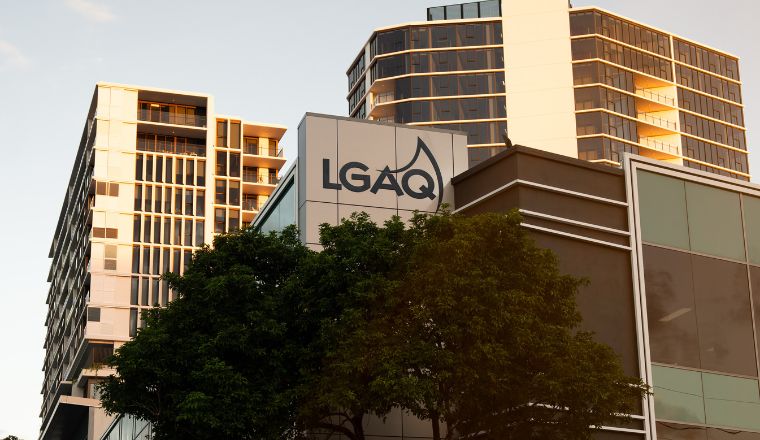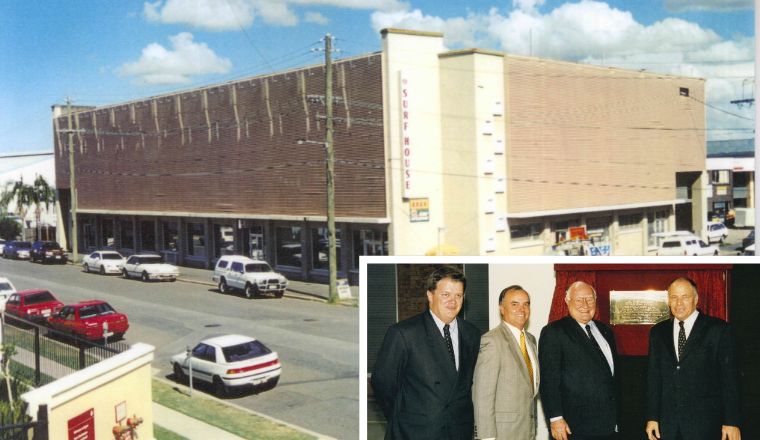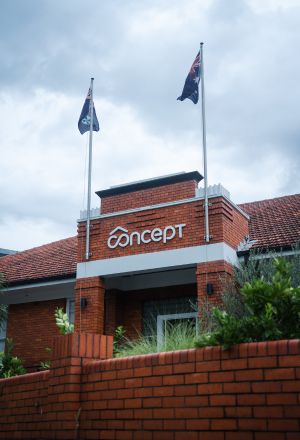Tim Cox / LGAQ Communications Advisor

Local Government House today at 25 Evelyn Street, Newstead. Photo: Jarrod Hellmuth
While it is rapidly being dwarfed by its high-rise Newstead neighbours, Local Government House still stands tall as a prudent choice, late last century, for a long-term headquarters for the LGAQ.
Twenty-five years ago, Terry ‘The Fox’ Mackenroth—the Minister for Communication and Information, Local Government, Planning and Regional and Rural Communities—officially opened the new building on 21 April 1999.
The ‘new’ Local Government House, at 25 Evelyn Street, is only a 10-minute walk across Breakfast Creek Road from the old one, at 60 Edmondstone Road (on the corner of Wickham Grove) in Bowen Hills and is packed with purpose-built facilities for members.
There is a dedicated members’ lounge on level one with various workspace configurations, including computer tables or more relaxed seating options, magazines, snacks, a private bathroom including shower facilities, and more.

25 Evelyn Street when it was the Surf Lifesaving HQ and inset L-R: Former LGAQ CEO Greg Hallam, developer Mr Bird, former LGAQ President Tom Pyne and former Queensland Local Government Minister Hon Terry Mackenroth at the official opening of LG House

The Members' Lounge at LG House
Meeting and training rooms of all sizes are available throughout for members to book and they’re all equipped with technology that makes presenting and hosting remote guests a breeze. The LGAQ encourages members to make use of the LG House meeting rooms when they’re in town, should they be meeting with ministers or other stakeholders.
In 2023, the LGAQ unveiled a shiny new space with backing from Telstra—the LGAQ Lab on the ground floor of LG House. The Lab is a digital solutions space designed to help councils get hands-on with demonstrations of new technology, collaborate with industry and peers, and work with the LGAQ’s data and digital team to achieve high-impact, low-cost solutions for councils’ digital dilemmas.
Ian Leckenby was one of the driving forces behind the modernisation of the LGAQ, serving as Director of the Association’s Business Support Branch from 1988 to 2006, and in a variety of sector-specific board roles across more than a quarter of a century, most notably for Local Government Mutual Services, including Local Government Workcare (LGW).
Ian says overcrowding, while an issue, wasn’t the catalyst for the move to larger premises. Rather, it was the creation of a self-insurance scheme for workers compensation (now LGW)—and a State Government stipulation that the scheme’s manager be accommodated with the Association itself.
“Originally, we were looking at options: buying a building, leasing a building or buying an old building and doing it up,” Ian recalled.
“And that's what we ended up doing – buying this building from the surf lifesavers and totally gutting it, renovating it and putting an extra floor on it. All that type of stuff.
“But the best business case for a new building was to actually lease rather than buy, and we took that to the executive and the executive said, ‘no way in the world—Queensland councils don't lease, we buy the property’ and, as it turned out, it was a perfect idea to buy this building and do it up because it’s now worth a whole lot more than what it was.”

The ‘Q Room’ meeting room at LG House. Photo: Jarrod Hellmuth
Digital Business Lead, Christine Krosch, is the LGAQ’s longest-serving staff member and says moving to the new building was a memorable experience.
“The day finally came after weeks of packing, during which time boxes filled with publications, documents and memories of projects completed were stacked in every corner of the old boardroom,” Christine said.
“I remember walking into the new building and thinking how wonderful the new, spacious, more open-plan layout was—you could almost see from one end of the office to the other! It was a very different feel to the old building that had been converted into an office space and felt a little more like a rabbit warren.
“The other thing I remember was the bright colours and the natural light that made it feel like a warm and welcoming space. During breaks, we could gather in the new lunchroom and enjoy views of the city, and everyone's new favourite meeting space was the ‘Skyline room’ for obvious reasons.
“Unpacking was made easy with the amount of storage we now had. Back in those days, the LGAQ sold many printed publications and, for the first time, we had dedicated storage areas to house everything. If ‘The Block’ had been a thing back then, I can imagine Shana Blaze saying ‘storage, tick’.”
But it’s the mention of something that didn’t make the move from the old building that surprised the author of this piece.
“When we left the Edmonstone Road office, we all had mixed feelings,” Christine recalled.
“Would the ghost that roamed the corridors of LG House move with us, or stay and make her presence felt with the new owners?”
Yoinks! Did Christine say ‘G-G-G ghost’?
“Would we continue to experience the eerie creaking sounds, papers or kitchen items randomly moving around, and the weird moment when the hairs on the back of your neck would just stand up? Would our friend continue with us, or would we be leaving that chapter behind and starting afresh?”
Ian Leckenby believes the answer lies, not in the spectral dimension, but in the muddy banks of Breakfast Creek (less than 200 metres away).
“If you know anything about the land down there, it's just all mud, and our foundations were basically floating in this mud, so when a vehicle would go past on Edmonstone Road the whole building used to shake,” Ian said.
“So, it had that quirkiness about it. And when they built the one in the back, they had to drive pylons down some 45 metres to get to them onto something firm.
“It used to be, at nighttime, if you were working back, you could actually hear someone walking around outside—but you could never find them—and some people actually refused to work back on their own, because they were spooked by this person that you couldn't see but could hear walking around the building because it had a wooden floor.
“I heard it so many times when I was working there, and lots of stories came out. Some people maintain that they actually saw the person… and you could sort of you could tell where they were by the sound, walking down that corridor between the rows of desks.
“Our former CEO Greg Hallam, I think he actually got a Catholic priest in, because he was a Catholic, to do whatever you do ... just in case it was an ‘evil spirit’.
“But, yeah, I never saw it.”

LG House’s former location, rumoured to be haunted. Photo: Jarrod Hellmuth
The ‘ghost’ of the old Local Government House appears to have moved on. When asked recently (LGAQ journos still use the doorknocking method when needed) if they’d witnessed any spectral activity, an employee of the current occupants, Concept Environmental Services, told us she’d heard the creaking and moaning of old casement windows, but alas, no suspicion of ghost activity.
Curiously, the old site has had two iterations as a location for soap and candle production. First by the Ross Soap Company, established by Peter Ross in 1883, and then by Melbourne-based ‘laundry leviathan’ J. Kitchen and Sons Pty Ltd, which saw the construction of the red-brick factory, laboratory and office building—the only remaining structure from this once-large local industry.
One of the products made by Kitchen and Sons would become a staple product in Australian bathrooms, workshops and schools. By ‘combining the cleansing power of pumice… with the deep-cleaning strength of natural citrus oils’, Solvol would have ‘workstained hands smooth and white again in no time’ and was ‘as pleasant to use as fine toilet soap’.
While Solvol survives (albeit in liquid form only) almost 110 years since its creation, the same cannot be said for a lesser-known Kitchen and Sons product—Witch Soap. ‘The Witch’ was ‘a modern wash day wonder worker’ that did ‘all the hard work of the wash’. In business for almost eight decades, J. Kitchen & Sons joined fellow soap manufacturer Lever Brothers in 1962 to form Lever & Kitchen—today part of the Unilever global conglomerate.
While it may not have the charm of a supernatural haunting, the location of LG House was selected in the late ’90s due to its proximity to the Brisbane airport and CBD and, in what was excellent foresight at the time, recognised it as an up-and-coming borough of Brisbane.
The iron skeleton of the No. 2 gasholder on Skyring Terrace is a visible reminder of Newstead’s industrial past, and the suburb was once a bustling home to timber yards, asbestos works, wharves and woolstores, many of which have been converted into highly desirable—and expensive—residences. A simple measure of how rapidly Newstead is evolving is its population, growing from 836 residents in the 2011 Census to almost 7,500 just 10 years later.
In recent years, Newstead has seen huge development to become one of Brisbane’s most trendy, coveted—and expensive—areas. In fact, a $1.5 billion eight-tower development for Newstead has been greenlit—just across the road from the LGAQ. The bustling site will feature retail spaces, plenty of greenery and will be sure to raise the value of its neighbours. In the meantime, we can only hope the construction across the street doesn’t stir up any wayward spirits...